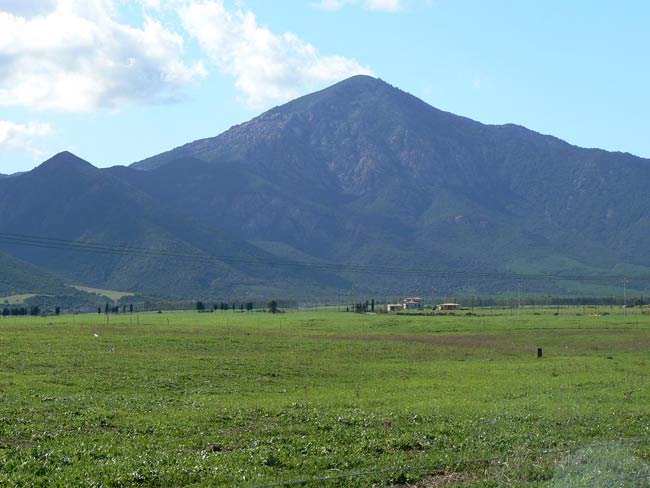Monte Arcosu (948 m.) is in the north-east part of Sulcis. It was a boundless private preserve, more than 3000 hectares and including, more than the mountain, a tangle of valleys that encircled it in the south and in the east; it is characterized by the presence of the cliffs, rocks, brooks, glades, tangled basin and the Sardinian deer.
When, in 1984, the preserved were abolished the owners decided to sell the whole area: it was risked, in that occasion, to lose one of the bigger jewellers of Sardinia.
Fortunately, the WWF undertake immediately an exciting campaign for awakening.
After numerous meeting, discussions, vicissitudes of enthusiasm and uncertainty, but above all, thanks to a big ability to hazard/of risk, the WWF arrives to a unique fund-raising that allowed to buy the Monte Arcosu area.
In 1985 the oasis became a WWF property and in 1987 it was declared wildlife reserve. Up to today it represents the sole accomplished example of park in Sardinia.
In 1995 were bought also the 600 hectares of Monte Lattias (1086 m.), opposite (to) Monte Arcosu, with the proceeds of a forest campaign.
Today Monte Arcosu is one of the most prestigious and symbolic wildlife reserves of WWF.
The entire complex has been declared “Oasis for the protection of the Wildlife of Sardinia”. It is subjected to landscape and ideological bond and marked as a protection zone by the CEE directive of the constituting Sulcis Regional Park.
The landscape
The whole complex is constituted by the massifs of Monte Arcosu and Monte Lattias, by the valleys of Guttureddu and Sa Canna and by a little part of the Gutturu Mannu Valley.
In general, the landscape appears rough and uneven; here granite and metamorphic formations standout and produce typical morphologies and geologic structures, often unique. Narrow valleys (some of them are also sunken), rocky faces and crests as those of Monte Lattias, of Su Scaloni and Sa Perrima follow one another.
The ideographic grid is very developed but the regime and the flow of all the rivers is torrential; the main rivers rise on Monte Lattias and Monte Arcosu: here we remember the Guttureddu and its main affluent, the rivulet Sa Canna.
El retículo ideográfico es bastante desarrollado pero el régimen y la capacidad de todos los cursos de agua es decididamente de tipo torrencial; Los principales arroyos nacen desde los montes Lattia y Arcosu (recordamos el arroyo de Guttureddu y su más importante afluente: el arroyo Sa Canna).
With regard to springs, the most striking is without doubt that of Su Suergiu. The water gushes out from a wonderful trunk of Juniper ably carved. The springs of Su Tragu and Sa Canna are very important too. The vegetation of the reserve is typically Mediterranean; In fact, here dominated the woods of holm-oak, cork-oak and bushes, in particular of heather and strawberry tree; also ancient specimen of juniper and carob stand out.
The undergrowth is the ideal habitat for numerous species of mushrooms (some of them are very rare and exclusive) and for the lichens (until now have been determined 219 species). It is possible to admire the viburnum, ferns (as Irish spleenwort, southern polypody and maidenhair spleenwort) and wonderful flowering of cyclamens. In the glades and in the edges of the woods it is often possible to run into common foxglove and species used in pharmacy as the cat thyme.
Near the torrents, dominate the scrub of oleander, the brush of purple willow and the wood of alder.
As regards the observable faunal area, the specimen more present in the reserve is, without doubt, the Sardinian deer; follows a large presence of wild pigs, as well as some specimen of fallow deer, fox and weasel. In the clearings it is possible to run into Sardinian partridge and wild rabbit. It is more difficult to see retiring nocturnal animals such as the Sardinian wild cat, the marten or the garden dormous. It is remarkable the presence of bird of prey, buzzard, kestrel, peregrine falcon, sparrow hawk, the flashy and noisy jay, thrush and Sardinian variety of the goshawk. In the crags of Monte Arcosu nests the golden eagle. Among the reptiles are present the viperine snake and the rare grass snake, the western wip snake, the country lizard and the Sardinian lizard.
Among the amphibian, instead, it is possible to admire the Tyrrhenian painted frog, the Italian cave salamander and the Sardinian tree frog always ably camouflaged on the leaves of some plant. Among the butterflies deserved to be mentioned the Sardinian swallowtail, the Two-tailed Pasha, the spurge hawk-moth and the fearful oak processionary, insatiable devourer of the leaves of ilex and cork-oak.
How to get there
By car from Cagliari: turn into the SS 195 (state road) to Pula. After about 5 km turn right, in the direction of “Zona Industriale Macchiareddu” and then take the 2nd strada ovest (west road) until the country Church of Santa Lucia.
Going on to Santadi you will find very soon a dirt road, well showed by road signs, which leads to the reserve’s entrance. The forest is in the interior of the oasis, after 10 km of a perfectly practicable dirt road.



















































